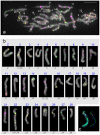Extensive conserved synteny of genes between the karyotypes of Manduca sexta and Bombyx mori revealed by BAC-FISH mapping
- PMID: 19829706
- PMCID: PMC2759293
- DOI: 10.1371/journal.pone.0007465
Extensive conserved synteny of genes between the karyotypes of Manduca sexta and Bombyx mori revealed by BAC-FISH mapping
Abstract
Background: Genome sequencing projects have been completed for several species representing four highly diverged holometabolous insect orders, Diptera, Hymenoptera, Coleoptera, and Lepidoptera. The striking evolutionary diversity of insects argues a need for efficient methods to apply genome information from such models to genetically uncharacterized species. Constructing conserved synteny maps plays a crucial role in this task. Here, we demonstrate the use of fluorescence in situ hybridization with bacterial artificial chromosome probes as a powerful tool for physical mapping of genes and comparative genome analysis in Lepidoptera, which have numerous and morphologically uniform holokinetic chromosomes.
Methodology/principal findings: We isolated 214 clones containing 159 orthologs of well conserved single-copy genes of a sequenced lepidopteran model, the silkworm, Bombyx mori, from a BAC library of a sphingid with an unexplored genome, the tobacco hornworm, Manduca sexta. We then constructed a BAC-FISH karyotype identifying all 28 chromosomes of M. sexta by mapping 124 loci using the corresponding BAC clones. BAC probes from three M. sexta chromosomes also generated clear signals on the corresponding chromosomes of the convolvulus hawk moth, Agrius convolvuli, which belongs to the same subfamily, Sphinginae, as M. sexta.
Conclusions/significance: Comparison of the M. sexta BAC physical map with the linkage map and genome sequence of B. mori pointed to extensive conserved synteny including conserved gene order in most chromosomes. Only a few rearrangements, including three inversions, three translocations, and two fission/fusion events were estimated to have occurred after the divergence of Bombycidae and Sphingidae. These results add to accumulating evidence for the stability of lepidopteran genomes. Generating signals on A. convolvuli chromosomes using heterologous M. sexta probes demonstrated that BAC-FISH with orthologous sequences can be used for karyotyping a wide range of related and genetically uncharacterized species, significantly extending the ability to develop synteny maps for comparative and functional genomics.
Conflict of interest statement
Figures



References
-
- Zbodnov EM, Bork P. Quantification of insect genome divergence. Trends Genet. 2007;23:16–20. - PubMed
-
- Adams MD, Celniker SE, Holt RA, Evans CA, Gocayne JD, et al. The genome sequence of Drosophila melanogaster. Science. 2000;287:2185–2195. - PubMed
-
- Holt RA, Subramanian GM, Halpern A, Sutton GG, Charlab R, et al. The genome sequence of the malaria mosquito Anopheles gambiae. Science. 2002;298:129–149. - PubMed
-
- Drosophila 12 Genomes Consortium. Evolution of genes and genomes on the Drosophila phylogeny. Nature. 2007;450:203–218. - PubMed
Publication types
MeSH terms
LinkOut - more resources
Full Text Sources
Research Materials

